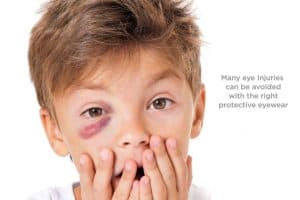In the United States, approximately 380,000 patients per year are seen by emergency eye doctors. Over 33% are children requiring emergency eye care.
While pediatric eye emergencies can be alarming, being prepared can make all the difference. Knowing what to do if a child has an eye emergency gives parents and caregivers peace of mind and increases a child’s chances of achieving the most optimal treatment results.
When it comes to pediatric eye care, remaining calm and seeking immediate medical attention is vital for both you and your child.
Every year, over 125,000 children in the US receive urgent medical care by emergency eye doctors.
Here are the five most common types of pediatric eye emergencies, and tips on how to manage them.
1. Acute conjunctivitis
This severe type of pink eye, formally called pediatric acute bacterial conjunctivitis, affects about 1 in 8 children every year. Acute conjunctivitis typically affects preschool children, toddlers and babies.
A child with this very contagious infection may experience eye discharge, itchiness and redness, usually in both eyes. Along with these eye symptoms, about 39% of children will also have a severe ear infection.
Treatment involves either oral or topical antibiotic medication, or in severe cases, both.
If your child shows any signs of acute conjunctivitis, contact an eye doctor near you for immediate treatment.
2. Blunt eye trauma
Blunt eye trauma can cause internal bleeding within the eye called hyphema. In severe cases, the extra blood within the eye can cause elevated inner eye pressure and lead to permanent vision loss. It usually happens during rough play or sports.
Typical symptoms after being struck in the eye include:
- Redness and swelling
- Eye drainage
- Eye pain that won’t go away
- Vision changes
- Visible abnormalities of the affected eye
- Visible bleeding in the white of the eye (sclera)
If your child has any of these symptoms, seek immediate medical care.
If you suspect your child has an eye injury, urgently contact an eye doctor near you who can diagnose and treat the condition.
SEE RELATED: What to Do for a Black Eye
3. Chemical exposure to the eye
A variety of household cleaning products can damage a child’s eyes and result in an eye care emergency. To protect your child’s eyes, keep these things locked away and out of reach.
If a child’s eye is exposed to a chemical, look for a phone number on the product’s label to dial in the event of an emergency or contact your nearest pediatric emergency eye care department.
Immediately after the incident: Hold your child’s eye open for about 20 minutes while you flush the eye area with clean water or saline drops. If both eyes have been exposed, place your child in the shower and have them face the water so it goes into their eyes.
4. Cuts or scrapes to the eye
Particles of dust, sand, wood shavings and other tiny objects can get into a child’s eye and cause a scratch on the surface of the eye, called a corneal abrasion.
Corneal abrasions may cause:
- Vision problems
- Stinging
- Burning
- Light sensitivity
- Red eyes
- Swollen eyes
- Grittiness
- Watery eyes
If you suspect that your child has a corneal abrasion, immediately contact an eye doctor near you for treatment.
Corneal abrasions are typically treated with eye drops, medicated ointments, and sometimes pain relievers.
To get the object or particle out of the child’s eye, rinse the affected eye with saline solution or clean tap water. They can also blink several times to try and flush out whatever is scratching the eye. Avoid rubbing the eye, as that can make almost any eye condition worse.
5. Foreign objects stuck in the eye
If your child is complaining that something is stuck in their eye, the first thing to do is to tell them not to rub their eyes. Visually inspect their eyes and see if you find anything. If a foreign object is on the sclera, the white part of the eye, try flushing the eye with saline solution or clean water.
If it looks like something is lodged in the eye or has penetrated the eyeball, do not try and remove it. Seek pediatric eye care immediately.
When it comes to pediatric eye emergencies, remaining calm is important for both you and your child.
LEARN MORE: Guide to Children’s Eye Exams
If your child has had an eye emergency, immediately contact an eye doctor near you who can help with eye emergencies and other eye care services.
While pediatric eye emergencies can be alarming, being prepared can make all the difference. Knowing what to do if a child has an eye emergency gives parents and caregivers peace of mind.
When it comes to pediatric eye care emergencies, remaining calm and seeking immediate medical care is vital for both you and your child.

